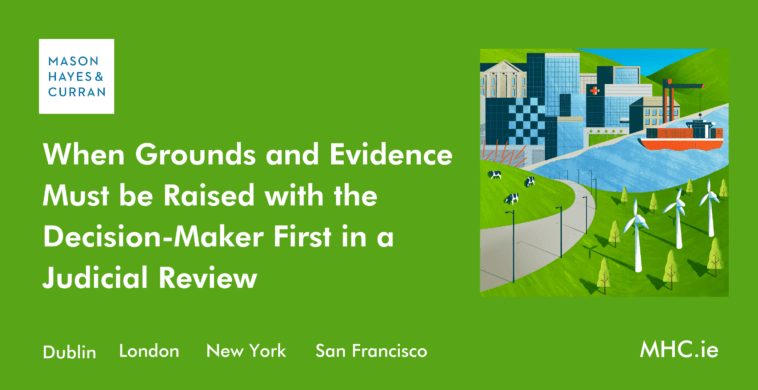
In this case, the question raised was whether or not evidence or grounds not previously brought before the decision-maker could be brought before the Court. The Judge, Mr Justice Humphreys, commented that a seemingly modest procedural application to exclude part of the applicant’s grounds and evidence, actually raised questions that go directly to the heart of what judicial review is.
Facts of the case
Intel Ireland Limited applied to An Bord Pleanála (ABP) for planning permission for the development of a manufacturing facility at Leixlip, County Kildare. Kildare County Council decided to grant permission subject to 34 conditions. The developer and the applicant in this case, Mr. Thomas Reid appealed permission to ABP. Following the recommendation of the inspector, ABP granted the developer planning permission on 23 November 2019, subject to 18 conditions. The applicant lodged a legal challenge claiming ABP’s decision was unlawful by providing various affidavits including one by a research scientist. The notice party lodged an application seeking to exclude the majority of the applicant’s evidence.
Requirement to submit grounds and evidence to the decision-maker first
Mr Justice Humphrey noted that the general rule on grounds first raised in Court is set out in the case of Lancefort Ltd. v An Bord Pleanála (No. 2) [1999] 2 I.R. 270. In this case, the Supreme Court held that grounds not brought before the decision maker first, cannot be brought before the Court. As a general proposition, it is considered unfair to expect a party to defend proceedings that were not brought to their attention prior to the granting of the planning permission, and instead raised during a judicial review.
Mr Justice Humphreys considered this legal principle has been developed further and there are exceptions to this rule. However, the general rule did still broadly apply to evidence or grounds that ABP would not normally have been aware of in making its decision. Mr Justice Humphreys outlined a few circumstances such as a relevant consideration that the decision-maker failed to take into account but wouldn’t normally have known about, or a special procedure that the decision-maker failed to follow, or a fact leading to bias.
The Judge gave an example to illustrate the point. If an applicant is seeking to use scientific evidence to cast doubt on a developer’s assessment of adverse effects on European sites, that evidence should be submitted to ABP before it makes its decision. In this case, Mr Justice Humphreys struck out most of the applicant’s scientific evidence, as these went to the merits of the planning decision.
Exceptions to the rule: EU Environmental Law and other instances
The Judge outlined 16 circumstances where new evidence or grounds that were not put before the decision-maker may be presented to the Court. Broadly an applicant can introduce new evidence or grounds regarding the decision-maker’s failure to act within its legal powers or follow the correct procedure. Another circumstance is where the applicant is pointing out omissions by the developer which the decision-maker would have been expected to spot. Furthermore, if the decision-maker makes a decision which is wholly unreasonable, or didn’t provide sufficient reasons, this would only come to light after the objection stage and so can be brought before the Court as a ground. New evidence can also be presented to explain material before the decision-maker, such as technical terms or facts. A new complaint may also be permitted if it engages the principle of access to justice under EU law.
In terms of the applicant’s evidence, Mr Justice Humphreys allowed a decibel chart which helped explain information before the ABP, as well as information on the Habitats Directive that was in the public domain. New evidence comparing engagement by two different planning authorities was allowed to show prejudice to the applicant but not in terms of the merits of the decision.
Conclusion
The judgment in this case affirms the general rule, unless an exception applies, that any new evidence or grounds from the applicant must be brought before the decision-maker before it can be brought before the Court. That said Mr Justice Humphreys did provide a significant number of exceptions although the majority did not apply to the applicant’s evidence.
As the Court is reviewing ABP’s decision based on the evidence before it, an objector should be required to raise its points with ABP first. This also allows the developer to respond to the information and ABP to take that response into account. This should ensure robustness in assessing the merits of the planning application. Developers should carefully analyse the applicant’s evidence and grounds, seeking to strike any out that don’t meet exceptions to the general rule.
For more information, contact a member of our Planning & Environment team.
The content of this article is provided for information purposes only and does not constitute legal or other advice.





